Congratulations to Lynn Salvo for breaking the USA W-E record in the oldest, female category. Lynn completed the 4029.1 miles from Ocean Shores, WA to Portland, ME at the age of 73 yrs 359 days. The minimum required distance for this record is 3200 miles which Lynn also exceeded greatly.
This eclipsed the current record of 67 years 78 days by 6 years 281 days. This is also a new Guinness World Record (GWR). This is the second time Lynn has set this GWR. She was 67 years and 32 days the first time.
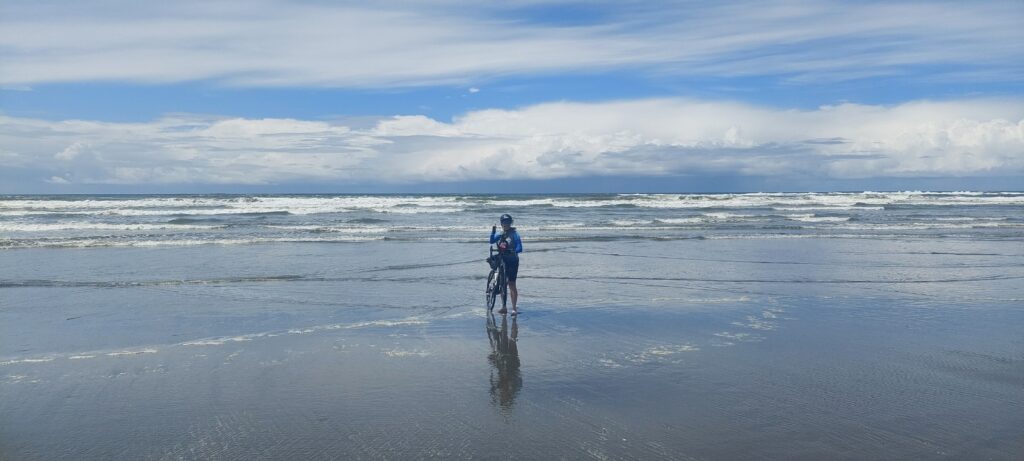
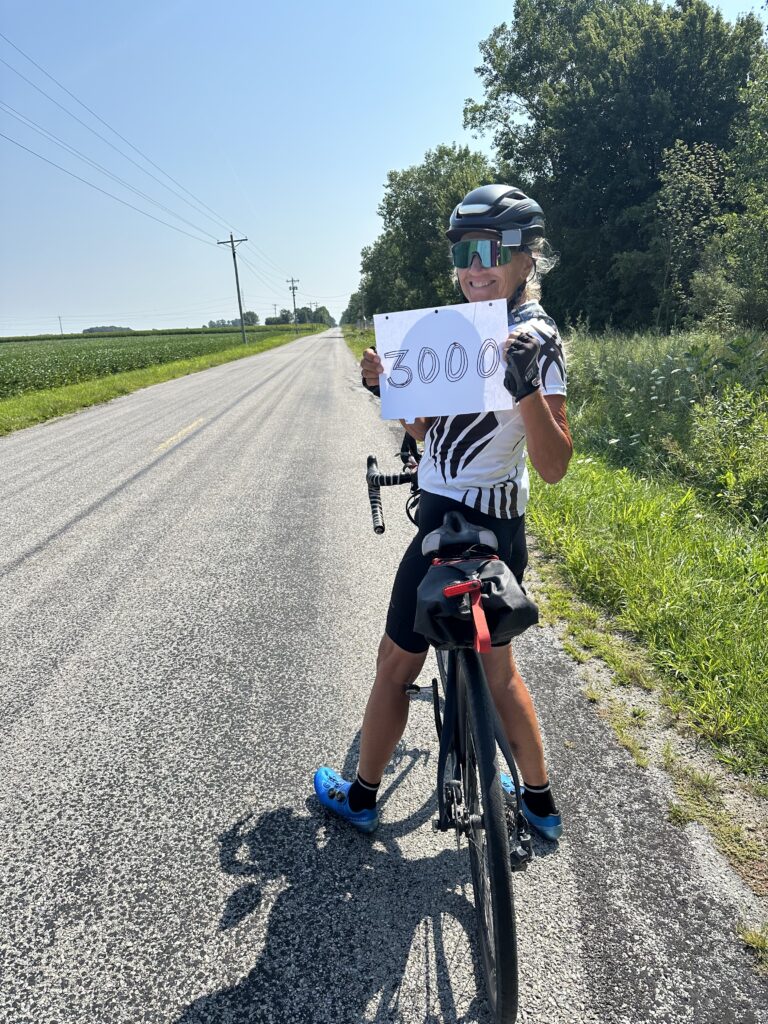
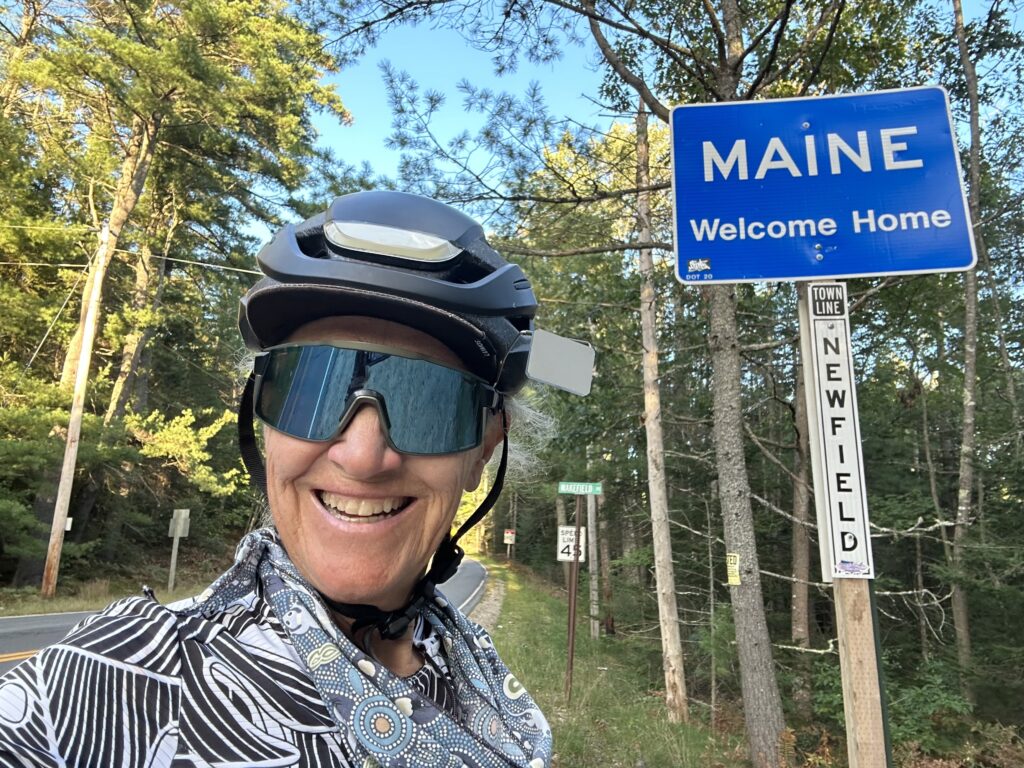
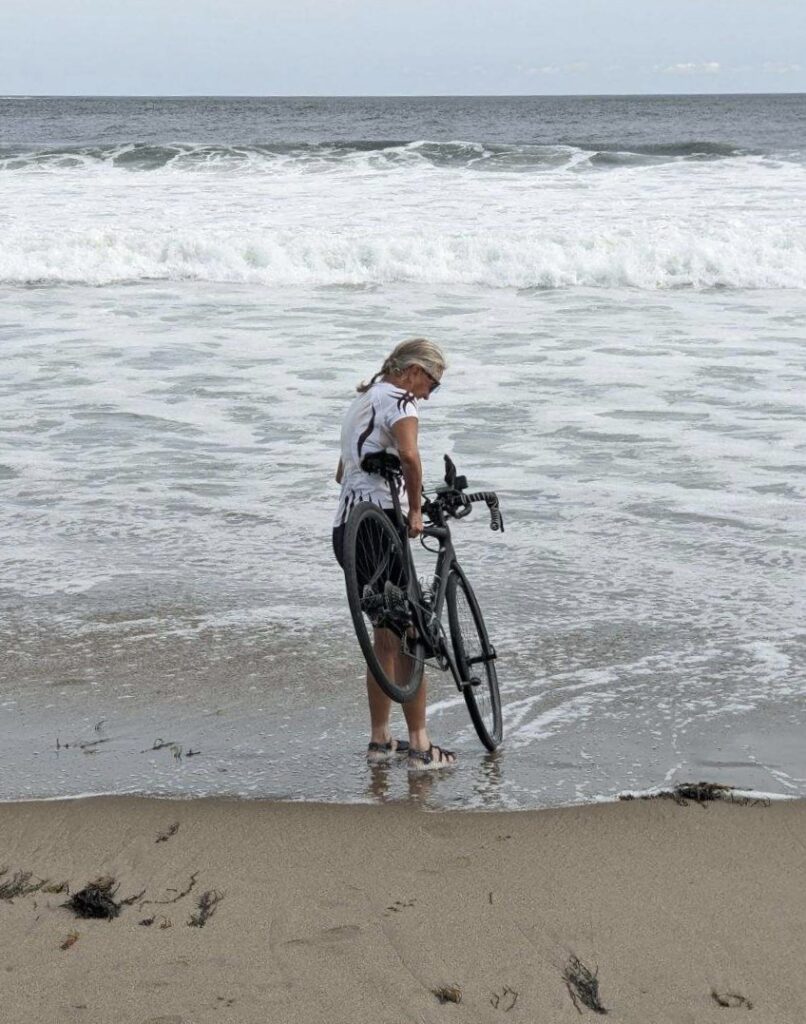
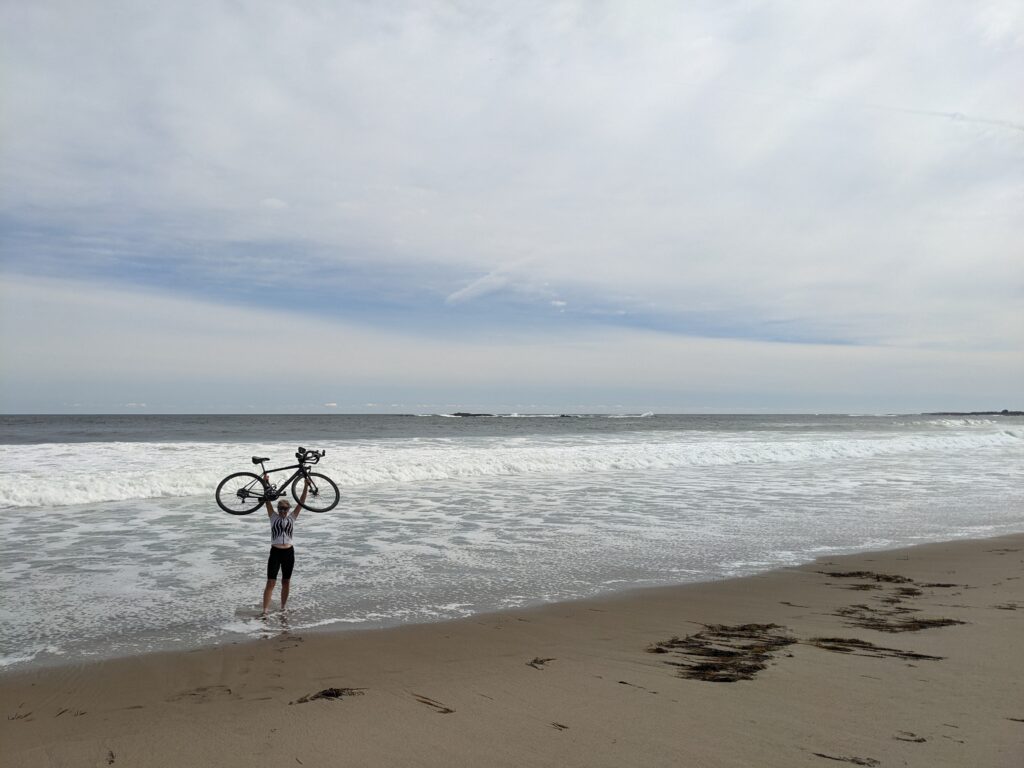
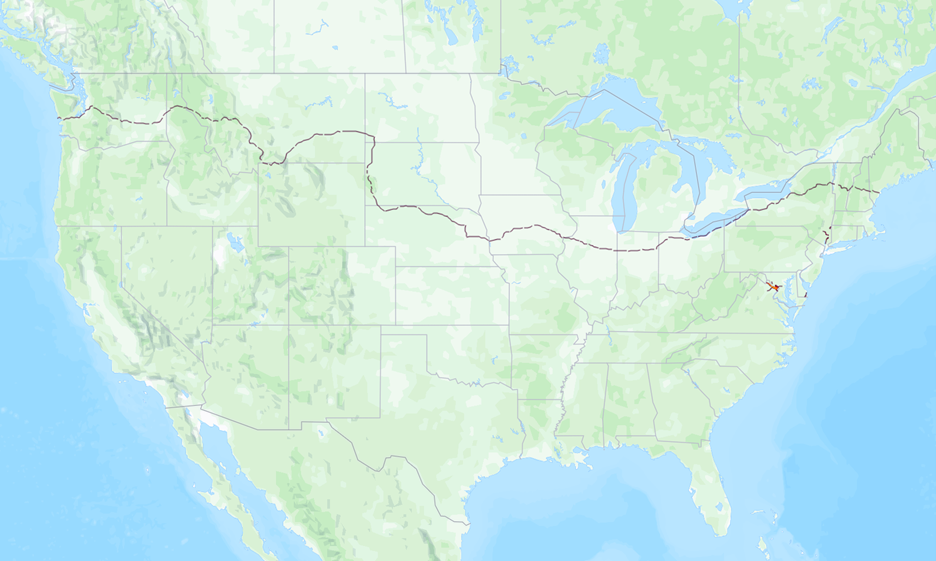
Diane Jenks’ podcast: https://outspokencyclist.com/2023/09/show-636-september-17-2023/
Ride Report:
Lynnea C. Salvo
WUCA and Guinness World Record Attempt
Oldest Female to Bicycle across the United States (West to East)
June 18 – Sept 15, 2023
Ride Report
In 2016, at the age of 67, I set my first Guinness World Record as the oldest female to cycle across the United States. Now, seven years later, because I can still do it at nearly 74 years of age and still enjoy the challenge, I’ve broken my own previous record. This is the fifth time that I have set a Guinness World Record.
It is also my fifth transcontinental bike ride. This time, I dipped my rear wheel in the Pacific Ocean at Ocean Shores, Washington, due west of Tacoma, on June 18, 2023, at 2:02 PM. Ninety days later, on September 15, 2023, after cycling 4029.10 miles and climbing 127,625 feet, I dipped my front wheel in the Atlantic Ocean at Scarborough Beach, Maine, near Portland, at 2:06 PM, less than five hours before the beach was to close in anticipation of the arrival of Hurricane Lee.
Epic bike rides fit my personality and my body. I love the many quiet miles I have to think while also being hyperaware of my surroundings for safety. I write a blog each day when on a trip. I let the blog title and contents emerge as the ride progresses and I think of turns of phrase as I go. I loved seeing the United States in granular detail at bicycle pace. I loved learning bits of history as I went, and I love tying together threads from one geographic place to another. History happens in places and I visualize the scene better when I’m present on the spot, especially when I’ve exerted effort to get there. One day I hope to write a book about my bike travels, especially the 14,500 miles that formed a peace sign the size of North America.
Each ride is different from others I have done, both in route and in company. The first half of this one was designed by my friend and cycling buddy, Callyn Worcester, who rode with me and our friend, Kay Spangler, for 2200 miles. When Callyn and Kay headed south to Wichita where they live, I continued eastward following a modified Northern Tier route.
I ride a Cannondale Synapse with Di2 shifters and disc brakes. My training plan is fairly simple. I keep up a base of 100 miles per week of cycling year-round. A ride like this record attempt requires about 300 miles a week. I gradually ramp up my miles about 10% a week, backing off every third or fourth week to let the training sink into my body.
I ate the healthiest food available, and only sparingly indulged in treats. I used ClifBars and ClifBloks during rides as needed. I shed 15 pounds during the three-month trip.
As normal on an epic bike ride, there are problems to solve. This ride presented its set of challenges. When I flew my bike to the West Coast, something happened with my hydraulic brake system, and I had to get my brakes bled before the first pedal stroke. In Billings, Montana, we experienced mild smoke from Canadian wildfires. There were some challenging gravel roads and trails. About a week after my cycling buddies from Kansas headed south, I, first, then my support person, Sandra, got COVID. There’s not much that is more isolating than a long bike ride, so I continued. In fact, I probably cycled for a week before I knew I had COVID. Later in Ohio, I failed to see an expansion joint in a bridge. It caught my wheel and I went down hard, really hard. A motorist pulled over almost before I reached the ground and pulled out medical supplies and stayed with me until he was sure I and my bike could continue. My right handlebar was bent inward, but it functioned. About a week later, at a bike shop on the Erie Canal, I got it straightened. In the process, I was unaware that the cable for my Di2 shifters had detached. As I resumed riding eastward, I realized that I was unable to shift my rear gears. Fortunately, I was just two miles from the bike shop that straightened the handlebars. Though Di2 shifters were not part of his repertoire, the mechanic quickly rose up the learning curve and fixed them, coached over the phone by my bike mechanic from home, Les Welch. At the very end, I had to race Hurricane Lee to the finish spot on the Atlantic Ocean. I combined six days’ worth of rides into three and reached the ocean five hours before the beach closed for the hurricane.
More common than problems, though, were Road Angels. Aside from the fellow who scraped me up off the bridge, numerous others helped. Robin Nelson reconnected our group when two riders missed a turn off of a highway. Another told me about a bridge that was closed sufficiently before I got to it that I was able to reroute without backtracking. Near the end, Beth Gorton baked a birthday cake for my support person, Susie. She also alerted me that I could go straight to the coast instead of on an arced route, thus saving several miles and hours of time ahead of the impending hurricane.
In addition to Road Angels, now that the ride is over, I can say out loud that I was incredibly lucky with weather. I only recall one ride that was distinctly in heavy rain. It was the third day on the road and it only rained during the last ten miles. One day in Iowa, there was a huge storm cell to my north and another to my south; my route went right between them. I was just east of a huge heat dome over the Midwest. I had only one headwind ride, east of Cleveland. As I mentioned, I had to race a hurricane to the coast, but I was quite fit by then and greatly motivated so I was able to accelerate the finish.
I am immensely grateful to the people who rode with me on their bikes and the ones who rode near me in a support car. Without them and the Road Angels, the ride would have been much more challenging. The following people were support drivers: Darryl Spangler, Sandra West, Michael West, Susan Schmitt, and Giampaolo Salvo. Sandra drove the bulk, nearly two months. That was a very long time to perform the demanding job of support driver. Near the end of her time, she had COVID and had to isolate instead of celebrating her major contribution in company. Near the finish, we learned that Hurricane Lee was expected to impact the location of the finish. My son, Giampaolo Salvo, handled important logistics to enable me to get to the Atlantic Ocean finish in three days instead of six. The following people rode with me for various lengths of time: Callyn Worcester, Kay Spangler, Lona McClanahan, Randi Korn, Kathleen Bauer, Rod Smith, and Mary Ellsworth, as well as several cyclists in the area of Ashtabula OH. I am also grateful to several people who hosted us and others who arranged special visits along the way. Thanks also to my husband who held down the fort and took care of our two elderly dogs while I was away for three months. I thank bison, bears, moose, antelopes, peahens, turkey vultures, butterflies, deer, and other wildlife for not objecting to me being in their space. I thank Indigenous People for giving names to so many places I traversed and I am sad that many no longer live in the places they named.
Cycling was the easy part. Managing diverse personalities and trying to make sure everyone’s needs were met while focusing on my goal was hard. At times, my support of the people who were supporting me was insufficient.
In addition, four of the five support cars had issues. Before the ride started, a tree fell on the first support car. It was fixed at 4 PM the day before it was needed. The second support car was involved in an accident, requiring Sandra to drive overnight to bring a substitute vehicle that became the third support car. It had an ongoing issue with road vibration possibly caused by unbalanced tires. The fourth car got a nail in the tire, requiring a roadside assistance mechanic to plug it. Only the fifth car had no issues, unless you count wipers not working properly. The more equipment, the more things can fail. There is something to say for self-supported cycling.
Although my body is still able to do this, other circumstances may prevent me from doing future epic bike rides, though there are three that I’d still like to do. First, my cycling buddy, David Goodrich, wants to cycle the East Coast to document places that one day will be underwater as the earth warms. He has inquired if I am interested. Second, I have been wanting to cycle from the Arctic Ocean to the Mediterranean Sea, (Norway to Spain), for at least five years. I first planned and booked it in 2020; it was foiled by COVID. In 2022, I booked it end to end for the second time; it was derailed by Russia’s invasion of Ukraine as well as a serious illness my husband fought, successfully. Third, I’d like to cycle a ride centered in Rhode Island that scribes a peace sign and a scale of justice. The second and third could be record-setting rides.
For me, bike touring is a very satisfying way to explore the world.
